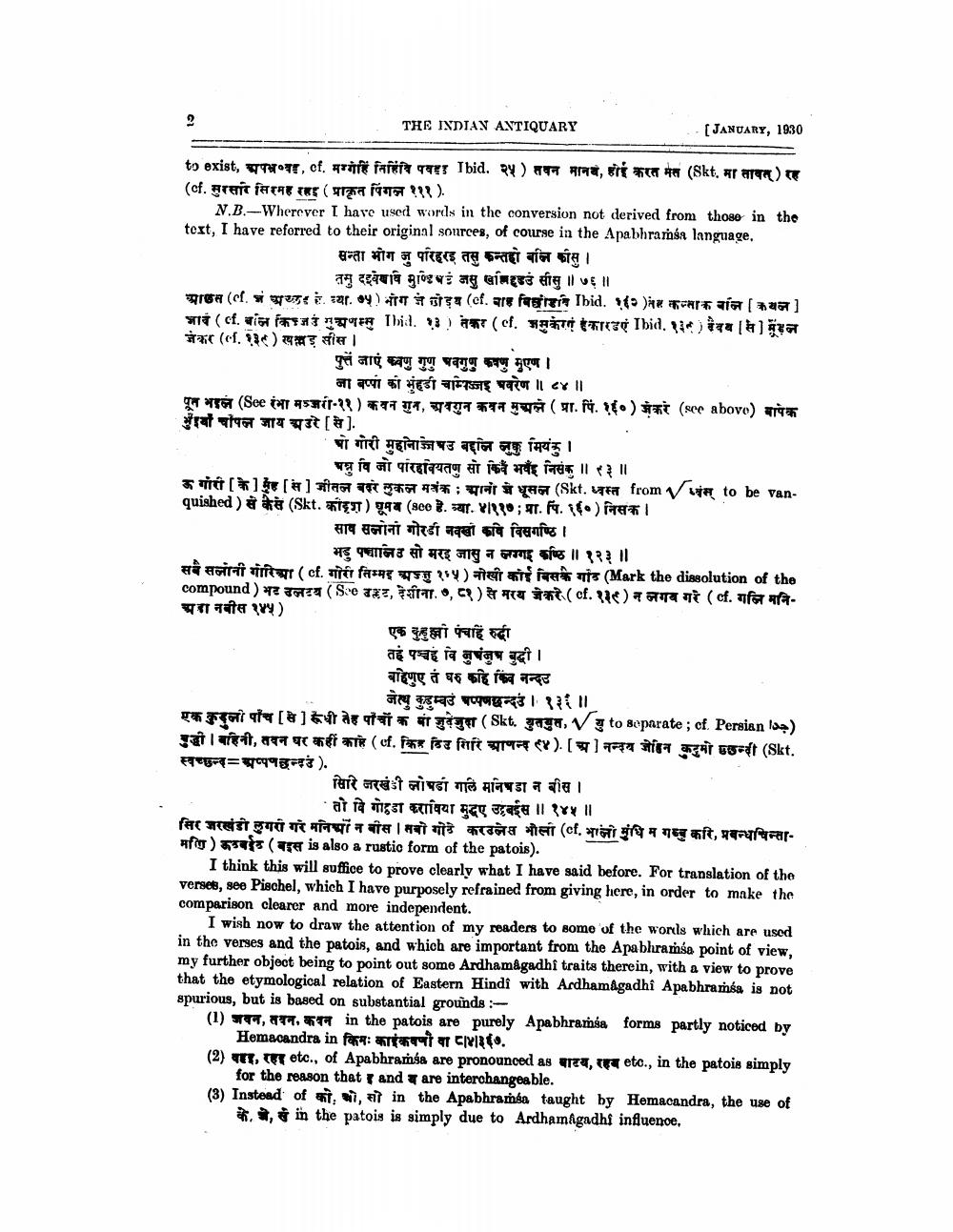Book Title: Indian Antiquary Vol 59 Author(s): Richard Carnac Temple, Charles E A W Oldham, S Krishnaswami Aiyangar, Devadatta Ramkrishna Bhandarka Publisher: Swati Publications View full book textPage 8
________________ THE INDIAN ANTIQUARY [ JANUARY, 1930 to exist, अपचया,of. मग्गहिं निहिंवि पहा Ibid. २५) तवन मानव, हो करत मत (Skt. मा तावन) रह (cf. मुरसार सिरमह रहा (प्राकृत पिंगन्न १११). N.B.-Wherever I have used words in the conversion not derived from those in the text, I have reforred to their original sources, of course in the Apabhramsa language, सन्ता भोग जु परिहरइ तसु कन्तहो बनि कीसु । तमु दईयावि मुण्डिप जसु खलिहडउं सीसु ॥ ६ ॥ पाउस (of. अगर व्या. ५) भोग जे छोड़ब (et. वाह विछोनि Tbid. t0) कन्नाकाज [ कयन] जावं (et. बलि किजउ मुअणम्म Til. १३) लेकर (of. जमुकंग इकारडएं Ibid. १३१) देवब [से मन जेकर (ल. १३८) खाइ सीस। पुतं जाएं क्यणु गुणु पवगुणु कपणु मुएण। ___ना बप्पा को मुंहडी चाम्पज्जइ अवरेण ॥ ४ ॥ पून भइल (See रंभा मञ्जरी-२१) कवन गुन, अवगुन कवन मुचले (प्रा.पि. १९०) शंकर (see abovo) बापक दुरयां चोपल जाय अउरे [से ]. पो गोरी मुहानाजघउ बद्दल लुकु मियंकु । भन्नु वि जो पारहावयतणु सो किव भइ निसंकु ॥ २३ ॥ जगारी [के] मह [स] जीतन बदरे लुकल मतंक: पानी में धूसन (Skt.यस्त fromve to be vanquished) से कैसे (Skt. कोदृश) घूमय (see है. व्या.१११७प्रा.पि. १६.)निसक। साव सलोना गोरडी नवखो कषि विसगष्ठि । भडु पञ्चालित सो मरइ जासु न लग्गइ कण्ठि ॥ १२३ ॥ सबै सलोनी गोरिया (ef. गोरी तिम्मद अन्तु १.५) नोखी कोई बिसके गांठ (Mark the dissolution of the compound) भट उलटय (Se उलट, देशीना..,८१) से मरय जेकरे (of. १३९) न लगव गरे (f. गलि मनिअहा नवीस १५५) एक कुडुला पंचाह रुदी तह पञ्चह वि नुजुत्र बुद्धी । बहिणुए तं घरु काहि किंव नन्दल जेत्यु कुटुम्बउं चप्पणछन्दउँ । १३६ ॥ एक कुली पाँच [से ] हंधी तेह पाँचों क या जुजुषा (Skt. युतयुत, यु to separate ; of Persian lan) पुद्धी । बहिनी, तवन घर कहीं काहे (of. किह ठिउ गिरि आणन्द (५). [अ] नन्दय जोहिन कुटुमी एछन्दी (Skt. स्वच्छन्द:अप्पणछन्द). सिरि जरखंडी लोपडी गलि मनिषडा न बीस । 'तो वि गोहडा कराषिया मुदए उहबईस ॥ १५ ॥ सिर जरखंडी लुगरी गरे मनिचों न बीस | मबो गोठे करउलेस भौली (ef. भालो मुंधि म गम्बु करि, प्रबन्धचिन्तामणि ) करबईट (बइस is also arustic form of the patois). I think this will suffice to prove clearly what I have said before. For translation of the verses, see Pischel, which I have purposely refrained from giving here, in order to make the comparison clearer and more independent. I wish now to draw the attention of my readers to some of the words which are usod in the verses and the patois, and which are important from the Apabhraṁsa point of view, my further object being to point out some Ardhamågadhi traits therein, with a view to prove that the etymological relation of Eastern Hindi with Ardhamågadhi Apabhramśa is not spurious, but is based on substantial grounds :(1) जवन, तकन, कवन in the patois are purely Apabhramsa forms partly noticed by Hemacandra in किमः काईकवनी वा ३६७. (2) वहा रहा etc., of Apabhramsa are pronounced as पाटब, रहब etc., in the patois simply for the reason that and are interchangeable. (3) Instead of को, भी, सो in the Apabhramba taught by Hemacandra, the use of # , & in the patois is simply due to Ardhamagadhi influenoe,Page Navigation
1 ... 6 7 8 9 10 11 12 13 14 15 16 17 18 19 20 21 22 23 24 25 26 27 28 29 30 31 32 33 34 35 36 37 38 39 40 41 42 43 44 45 46 47 48 49 50 51 52 53 54 55 56 57 58 59 60 61 62 63 64 65 66 67 68 69 70 71 72 73 74 75 76 77 78 79 80 81 82 ... 380
